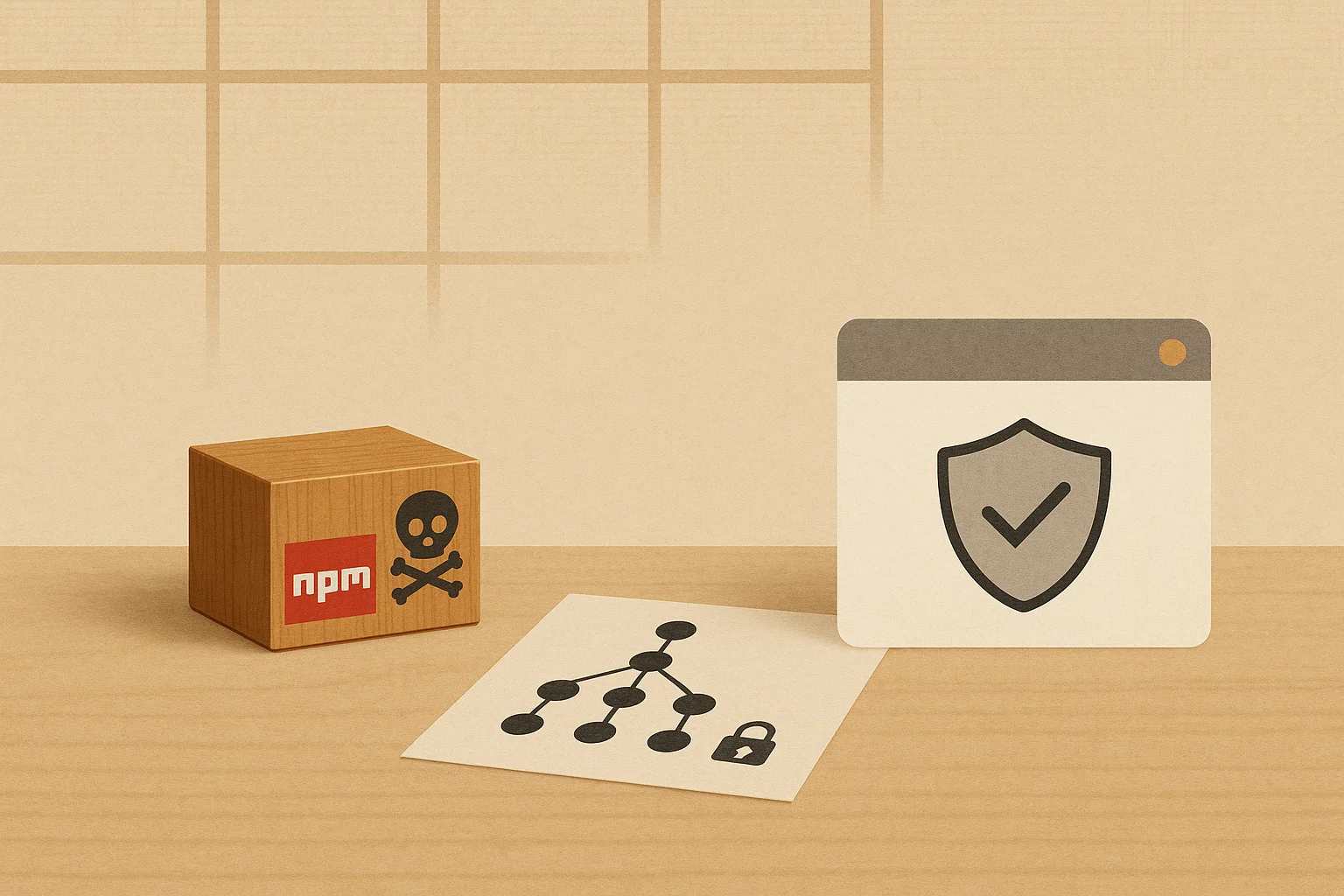NPM Supply Chain Attack: What Happened and How to Protect Your CI/CD (2025)

This post distills a recent analysis from Palo Alto Networks on an NPM supply chain attack into an actionable, engineer‑friendly guide. We focus on how the attack works, why it’s dangerous for developer machines and CI/CD, and what concrete steps reduce your blast radius.
What happened (at a glance)
Threat actors published malicious NPM packages that looked legitimate (typosquatting or brand‑adjacent names), then used install/postinstall scripts and obfuscated payloads to exfiltrate environment data and credentials. Once a developer or CI pulled the package, the attacker could reach tokens, SSH keys, or internal endpoints.
Attack chain breakdown
- Package discovery: Developers add a seemingly helpful utility or a dependency pulls it in transitively.
- Installation hook:
install/postinstallscripts run duringnpm install/pnpm install/yarn. - Payload fetch or embedded malware: Obfuscated JS downloads a second stage or executes an embedded data‑exfiltration routine.
- Credential and env theft: Scrapes env vars (cloud tokens, org secrets), local config files, git credentials, or queries internal endpoints from within CI.
- Lateral movement: Stolen tokens allow access to private registries, source control, or artifact stores.
Why this hits CI/CD so hard
Build agents often have broad secrets and network reach. If a malicious package executes in that context, it can harvest tokens, sign artifacts, or publish backdoored builds. Because the code rides in via dependency resolution, it can bypass perimeter controls unless you have explicit policy gates.
What to do now: Pragmatic hardening checklist
- Lock dependencies: Commit lockfiles; pin versions for production builds; require PR review for any lockfile diff. Prefer immutable installs (e.g.,
npm ci,yarn install --immutable,pnpm install --frozen-lockfile). - Block lifecycle scripts in CI: Run installs with
--ignore-scriptsin CI and re‑enable only for known‑good packages. TreatprepareandprepublishOnlyas risky as well. - Use a private registry mirror with policy: Proxy NPM through an internal registry that applies allow/deny rules and malware scanning.
- Enforce scoped registries and auth: Map
@your-scopeto your private registry and avoid implicit registry switching; usealways-authonly where required. - Enforce provenance/signing: Prefer packages with provenance (SLSA, Sigstore). Verify signatures where supported.
- Least privilege in CI: Scope tokens narrowly; rotate frequently; block outbound network egress by default; allowlist destinations.
- Detect risky diffs in PRs: Flag new packages, owner changes, newly added install scripts, or unusual publish activity for review.
- Monitor egress: Alert on unexpected DNS/HTTP from build agents, especially to pastebins or disposable domains.
Policy-as-code: block install scripts by default (GitHub Actions)
Enforce safe defaults in CI: block lifecycle scripts globally, then allowlist only specific packages when truly required. Here’s a compact GitHub Actions example:
name: ci
on: [push, pull_request]
jobs:
build:
runs-on: ubuntu-latest
steps:
- uses: actions/checkout@v4
- uses: actions/setup-node@v4
with:
node-version: '20'
cache: 'pnpm'
- run: corepack enable
- name: Enforce safe install defaults
run: |
npm config set ignore-scripts true
npm config set audit false
npm config set fund false
- name: Install (no scripts, frozen lockfile)
run: pnpm install --frozen-lockfile --ignore-scripts
- name: Verify lockfile unchanged
run: git diff --exit-code -- pnpm-lock.yaml || (echo 'Lockfile drift' && exit 1)
- name: Fail on newly introduced lifecycle scripts (allowlist exceptions)
env:
# Allow known packages that require native bindings or codegen.
# Include your internal scope as needed, e.g., ^@your-scope/
ALLOWLIST: "^(esbuild|sharp|@swc/|@next/swc|prisma|husky|node-pre-gyp|@mapbox/node-pre-gyp|canvas|fsevents|better-sqlite3|^@your-scope/)"
run: |
jq -r '.. | objects | select(has("scripts")) | .name + " " + ( .scripts|tostring )' ./node_modules/**/package.json | grep -Ei '\b(preinstall|install|postinstall|prepare|prepublishOnly)\b' | grep -Eiv "$ALLOWLIST" && { echo 'Found lifecycle scripts in non-allowlisted packages'; exit 1; } || true
- name: Build
run: pnpm build
Notes: Use your package manager of choice (npm/yarn/pnpm). Keep an explicit allowlist for packages known to require installation scripts; everything else should be blocked. Review the allowlist quarterly and keep it as small as possible.
Developer workstation safeguards
- Use separate, scoped tokens for local dev; avoid org‑wide tokens.
- Run node tooling in sandboxes/containers where feasible.
- Prefer
pnpm/npmconfigs that warn on scripts and new bins; considernpm_config_ignore_scripts=truewhen working on risky branches. - Keep Node.js and package managers up to date; apply security advisories promptly.
How to catch this earlier in code review
- Require human review for lockfile changes and new transitive trees.
- Highlight lifecycle scripts and native bindings in newly introduced packages.
- Track package ownership/maintainers; flag sudden ownership transfers.
- Pin registry source (avoid implicit registry switching).
Incident response playbook (condensed)
- Identify impacted repos and CI jobs; diff dependency graphs by build ID.
- Rotate secrets used by affected agents and developers; revoke tokens proactively.
- Rebuild clean artifacts from known‑good states; verify provenance.
- Hunt for suspicious egress from build runners; block indicators of compromise.
- Backfill guardrails: lockfile review, script blocking, registry policy.
Related internal reading
- Supply Chain Security in Code Review: Dependency Analysis Best Practices
- Security Code Review That Stops 99% of Vulnerabilities (2025)
- Security Code Review: A Practical Guide for Engineering Leaders
- Infrastructure as Code Security Review: Terraform and CloudFormation Best Practices
- Cursor AI Vulnerability CVE-2025-54135: Security Analysis and Implications
- CodeRabbit Vulnerability: How a Simple PR Exposed 1M Repositories
References
- Palo Alto Networks: NPM Supply Chain Attack — Analysis and IOCs: https://www.paloaltonetworks.com/blog/cloud-security/npm-supply-chain-attack/
- NPM — Handling malicious packages (advisories and policy): https://docs.npmjs.com/about-audit-resolving-vulnerabilities
- NPM — Lifecycle scripts reference: https://docs.npmjs.com/cli/v10/using-npm/scripts
Harden Your Pipeline Against Supply Chain Risk
Use Propel to surface dangerous dependency changes in PRs and enforce policy before code merges.


